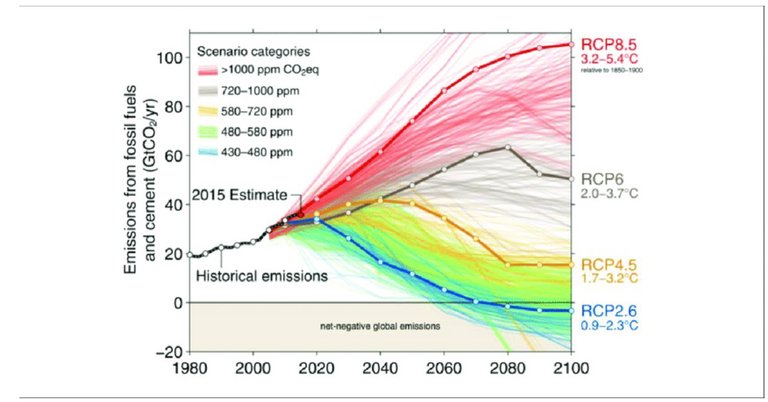Useful info or a scenario used to generate Climate Porn?

Most extreme climate forecasts are usually based on the so-called RCP8.5 scenario. This is regularly presented as the "business as usual scenario" that awaits us if there is no effective climate policy. But that is not entirely true.

How much will the sea level rise by the end of the century? What increase in heat waves can we expect? In order to gain insight into the possible climate change in the future, the Intergovernmental Panel on Climate Change (IPCC) has developed various scenarios, the so-called RCPs or Representative Concentration Pathways. Actually it is a family of scenarios because every RCP describes different ways to get the same warming at the end of the century. In the best-case scenario, the RCP2.6 scenario, the earth warms up on average by 0.9 to 2.3 degrees Celsius by the year 2100. In the worst case, RCP8.5, we can expect a warming of 3.2 to 5.4 degrees.
RCPs are a set of four new pathways developed for the climate modeling community as a basis for long-term and near-term modeling experiments. The four RCPs together span the range of year 2100 radiative forcing values found in the open literature, i.e. from 2.6 to 8.5 W/m2. The RCPs are the product of an innovative collaboration between integrated assessment modelers, climate modelers, terrestrial ecosystem modelers and emission inventory experts. - Piece of text from "Climatic Change. The representative concentration pathways: an overview."
What it will ultimately be, depends on greenhouse gas emissions. Each RCP scenario makes assumptions about technological innovation, land-use change, economic development, and population growth. How much will the world's population increase? Shall we continue to deforest our planet or will we en mass plant trees again? How cheap does renewable energy become? It shall all determine how quickly emissions fall.
Most pessimistic predictions - whether we are talking about hurricanes, sea level or the impact on biodiversity - are generally based on the RCP8.5 scenario. This is often presented as the business-as-usual scenario, in which we are unable to reduce emissions with vigorous climate policy. For example, following the latest IPCC report, various media presented the sea level rise of 60 to 110 centimeters expected in the RCP8.5 as what awaits us "with unchanged policies".
Climate Porn
That's not right, American scientist Roger Pielke (University of Colorado) recently stated in Forbes magazine:
The misuse of RCP 8.5 involves the transformation of what is more accurately described as a worst-case scenario into the sole “business as usual” or baseline scenario that has become a centerpiece of climate policy discussions.
Thus, the result, according to Pielke, is that we start to regard the most pessimistic outcome as the most likely.

Image Credit: Neil Craik, University of Waterloo
Is that bad? The RCP8.5 scenario assumes that there will be no effective climate policy. Moreover, in this scenario, the population is growing rapidly, there is little technological innovation and we continue to burn a lot of coal. You see, many things have to go wrong. That is not impossible, but not very likely. It can never have been the intention to turn RCP8.5 into the business-as-usual scenario.
In addition, if we base ourselves on a misleading scenario, it will have an impact on our thinking about effective measures. You also make people more afraid than necessary. That weakens confidence in science. Climate change is big news in itself. I mean, why do you want to make this worse than it already is? This is not the kind of problem that one wishes to sensationalise. I don't believe fear to be an effective motivator.
Optimistic
But isn't our still rising CO2 emissions close to what the RCP8.5 scenario describes? Until 2014, that was indeed the case. This has contributed to the fact that many think about the RCP8.5 as the "business-as-usual scenario". But: since then, the increase in emissions has been less strong.
Moreover, a number of events are cautiously optimistic. The cost of renewable energy is falling rapidly, and there is the Paris Climate Agreement. We do not yet see a spectacular effect on emissions, but it does offer hopeful perspectives. It is becoming less and less likely that we will end up in an RCP8.5 scenario.
Some critics wonder if after the Paris climate agreement it makes sense to talk about business as usual scenarios without climate policy. After all, there is climate policy. Yet this remains important because the current policy is not enough. Yes, the agreements made in Paris will have an effect. But with all the stated ambitions, we are unable to limit global warming to 2 degrees Celsius. And if we do not look at what has been promised, but only at what has already been effectively implemented, we are still heading for global warming above 3 degrees Celsius.

Photo by Jon Tyson on Unsplash
Even then enormous challenges await us. The most serious climate risks of RCP8.5 may be less likely this century than they are sometimes suggested, but the more likely consequences are still serious enough to pursue ambitious climate policies. Moreover, the RCP8.5 scenario remains a possibility. That is why it is still useful. It is good to know what awaits us in the worst case. You only have to state clearly that this is a pessimistic scenario.
Briefly summarized from another interesting article (source mentioned below):
RCP 8.5 is in line with the current trajectory of emissions and in line with the pathway promoted by those policy-makers championing the use of fossil fuels such as coal-fired power. However, looking decades ahead, emissions on the current business-as-usual trajectory may ultimately come close to but fall short of, the emissions usually associated with RCP 8.5. Some researchers have identified RCP 7 as a more accurate representation of the emissions in the years further out along the current business-as-usual pathway.
Managing climate change is essentially a risk management exercise, and as such, it is important to know the impacts projected under both high and low emissions scenarios, regardless of the likelihood of each scenario.

First photo by Simone Busatto on Unsplash
Sources:
"Climate Porn" is an amazing idea and really encapsulates all the down side of the endless fear-mongering. Yes, we ARE in a climate change intensive phase. But the world has been ever evolving and maybe we are simply RECORDING and able to share information differently, and maybe, really, in the great scheme of things not that much has changed.
I'm really into being EMPOWERED, not paralyzed by doom and fright and desperation.
Leading the curation trail for both @ecotrain & @eco-alex.
Together We’re Making This World A Better Place.
Click Here To Join the manually curated trail "@artemislives" to support quality eco-green content.